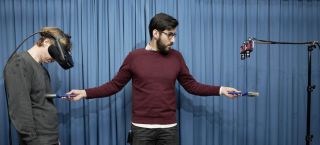Surprising results from a high-tech study of stress and anxiety.
Post published by Fjola Helgadottir Ph.D. on Apr 25, 2015 in Man Talks to Machine
 What is it like to be invisible? In the past hypothetical questions
like this could only be explored through thought experiments and science
fiction. However, today scientists can use technology to help dig for
clues. A recent study published in Scientific Reports (link is external) used a clever experimental design to make people feel as if they were invisible, and investigated how that made them feel.
What is it like to be invisible? In the past hypothetical questions
like this could only be explored through thought experiments and science
fiction. However, today scientists can use technology to help dig for
clues. A recent study published in Scientific Reports (link is external) used a clever experimental design to make people feel as if they were invisible, and investigated how that made them feel.The researchers used an extension of the well-known rubber hand illusion (link is external) to encompass the entire body: A participant wears a head-mounted display that gives them a live 3D view from the perspective of a fake body elsewhere in the room. Using a number of tricks, such as reproducing tactile stimulations, it is possible to make the participant disassociate from their own body and adopt a new one. Taken one step further, it is possible to create the illusion that their body is completely invisible to themselves and others.
One goal of the study was to examine the relationship between being invisible and having social anxiety. Standing in front of an audience is known to be stressful for those with social anxiety. The researchers placed subjects in front of an audience and monitored physiological responses and administered psychometric questionnaires. They conducted the same experiment for participants with "invisible" bodies and found that social anxiety symptoms were significantly lower for subjects in an invisible state.
This is a fascinating result, as it shows a deep connection between how we feel and how we believe others perceive us. This isn't an entirely new or unexpected result, as it is related to a phenomenon known as observer bias (link is external), in which people with social anxiety see themselves from the vantage point of others, instead of their own. Further, they typically see a version of themselves that has been distorted in a negative way. Many social anxiety treatments (such as Overcome Social Anxiety (link is external)) use a technique known as "attention training" to help people rid themselves of this observer bias. One possible factor in the invisibility study is that observer bias is decreased when people view themselves as invisible.

Source: Staffan Larsson
Dynamically altering visibility is a radically innovative idea and an exciting use of technology. I am very eager to see how this research unfolds.
没有评论:
发表评论